Have you ever seen a stunning variegated plant and wondered how you would care for such an assortment of distinctive foliage? You’re at the right spot, then. Read this Syngonium Variegata care guide.
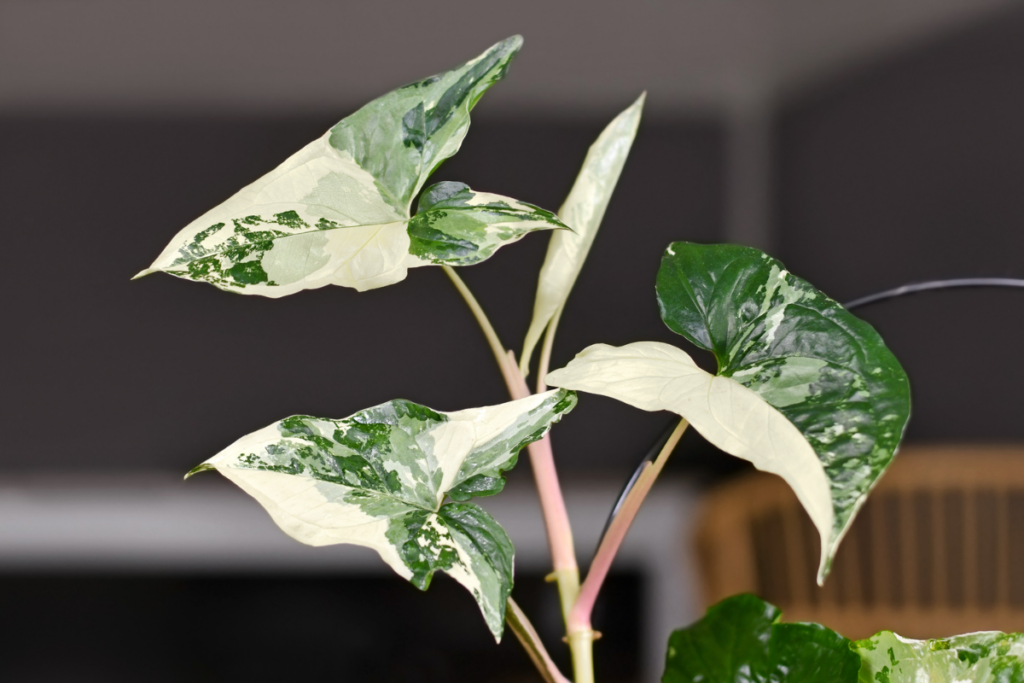
Variegated Syngoniums are one of the most popular variegated plants that are commonly used as indoor plants. This plant can definitely brighten up drab areas of your house and yard with its green stems and white and light green foliage.
One of the most valued characteristics of this plant is its simplicity of maintenance. In addition to growing quickly, they reproduce rather easily. These are one of the family greenhouse’s hidden “gems.”
Would you want to learn more about this beautiful plant? This guide will cover both plant maintenance and every other aspect of this magnificent plant that you should be aware of!
Syngonium Variegata Care Profile

General Information
Syngonium variegata (Syngonium podophyllum) is an expressive, rarity evergreen aroid of the Araceae family. It is a tropical plant that may develop into a bushy houseplant, vine, or terrarium plant.
It is a climbing vine native to South America’s tropicaland subtropical regions such as Bolivia, Brazil, and Mexico. It is also known as Syngonium podophyllum, Variegated Arrowhead Vine.
It features arrow-shaped light green leaves with white variegations. Indoor growers admire them for their multicolored foliage. They feature a lot of white on a bright green backdrop.
Syngonium is a vine with a single long stem that grows from the base of 16-65 feet (5-20 m in nature, up to 6.5 feet) tall (2.5 m in an indoor setting).
Etymology
Syngonium derives its name from the Greek words “syn” (together or joined) and “gone” (womb), referring to its joined or united fruit ovaries.
On the otherhand, the specific epithet name “variegata” refers to the desired aroid with arrow-shaped leaves marbled with varied hues of green and pure white spots. A unique and sought-after cultivar with distinctive arrowhead-shaped leaves and amazing variegation.
Flowering
The blossoming of Syngonium variegata happens exclusively on mature vines cultivated outside in tropical areas. This makes the chances of a plant in your house flowering extremely unlikely.
It has arum-like blooms but is rarely grown. The blossoms are green and white and resemble a peace lily. They have little black, brown, or red berries. The blossoms have no scent.
Seasons of Interest and Purchasing
Syngonium variegata grows from early spring to late spring. They may be gathered and used to decorate other flowers in a vase. This is a lovely decorative plant that may also be kept indoors in a container.
This is the plant to choose if you want a low-maintenance indoor plant. It adds exotic flair to the interior decor while also improving air quality.
Syngonium variegata have miniature and dwarf varieties which can be found on Etsy or at one of these rare plant stores. Plant breeders usually propagate different varieties of Syngoniums such as Pink Splash, along with Syngonium Variegata.
Growth
Syngoniums are rapidly growing plants that may reach heights of 32–65 feet when grown outdoors. However, when grown inside, it only grows to be 3-6 feet tall and 2 feet wide.
The Syngonium variegata have leafy stems that grows in an upright style and has a high growth rate because it is a vine.
Syngonium Variegata Overview
| Scientific name | Syngonium podophyllum ‘Variegata’ |
| Common name/s | Variegated Arrowhead Vine, Syngonium Variegata, Syngonium Albo |
| Family | Araceae |
| Growth Habit | Herbaceous Vine |
| Height and Spread | Can grow up to 32-65 feet in height in the wild, and 3-6 feet tall indoors |
| Classification based on life cycle | Perennial |
| Origin and Distribution | Native to the West Indies, particularly Bolivia, Brazil, Mexico, Ecuador |
| Climate Zone | Generally warmer climate |
| USDA Plant Hardiness Zone | USDA Zone 10-12 |
| Color | Arrow-shaped leaves marbled with varied hues of green and pure white spots |
Related: Pink Syngonium: The Number 1 Care, Propagation, and Watering Guide
Care Tips
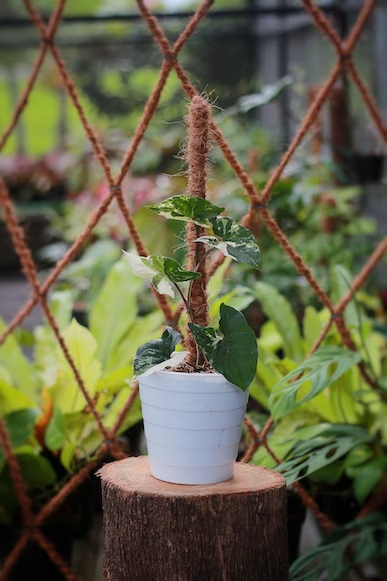
Light Requirement
Syngonium variegata flourishes, and variegation is best at bright light that is indirect. It can grow in a shaded environment, but they will not flourish. In general, bright indirect sunlight is preferable. The leaves of your indoor plant may burn if you expose them to direct sunlight.
Overexposure to direct sunlight can cause the leaves to burn and turn white. With that in mind, it’s critical to choose a location with a good mix of bright and shady settings. This also promotes increased variegation and vivid foliage.
Temperature Requirement
These plants will flourish in a normal home or office setting since they appreciate a warm atmosphere. Maintain a temperature of 60 to 80 degrees Fahrenheit (15 to 26 degrees Celsius). Keep the temperature in the room above 60°F.
This guarantees rapid and ideal development. Keep the Syngonium away from areas with temperatures below 65 degrees Fahrenheit to prevent stunted development. Additionally, keep the plant out of direct sunlight to avoid excessive temperatures. The result will be a houseplant with weak, drooping leaves.
Water Requirement
Arrowhead plants should be kept damp but not wet. When the soil’s surface begins to feel dry, water sparingly. These plants have moderate drought tolerance.
Water your Arrowhead plant when the top inch of the soil surface seems dry to the touch. You want topsoil that is wet but not waterlogged. Furthermore, with frequent hydration, the plant grows speedily.
Therefore, young plants need less water, and mature plants require regular irrigation. Make sure the water is balanced properly and that the substrate has adequate drainage.
Humidity Requirement
The success of growing arrowhead vines is influenced by the relative humidity. For Arrowhead, a moderate humidity of around 40–50% is tolerable.
It helps the environment become more humid, which is wonderful for growing different kinds of houseplants and retaining their vivid colors and patterned leaves.
Anyway, there are ways to obtain this high humidity, such as washing the leaves, spraying the leaves once a week, and utilizing a plant saucer tray and a room humidifier.
Soil Requirement
To guarantee that the soil is both nutrient-rich and well-drained. A light substrate combination with mild acidity is the ideal soil for growing Syngonium. A pH level range of 5.5–6.5 is ideal.
In addition, it has to have appropriate drainage, water retention, and aeration qualities in order to create a more effective soil blend (such as perlite and moss).
Fertilizer Requirement
In order to provide Syngonium variegata with the nutrients it needs to flourish, fertilizer will be required during the growth season.
Therefore, it is advised to add some slow-release fertilizer and feed once a month in the spring and summer to encourage growth. Additionally, the optimum fertilizer option is one with an NPK ratio of 7:9:5.
Space Requirement
Syngonium variegata flourishes in wide drainage holes at the base of ceramic, terracotta, or hanging planters. This plant should be maintained at least 2.5 feet apart from its neighbors since it has the potential to become quite large if given enough room to climb.
Growing and Planting Tips
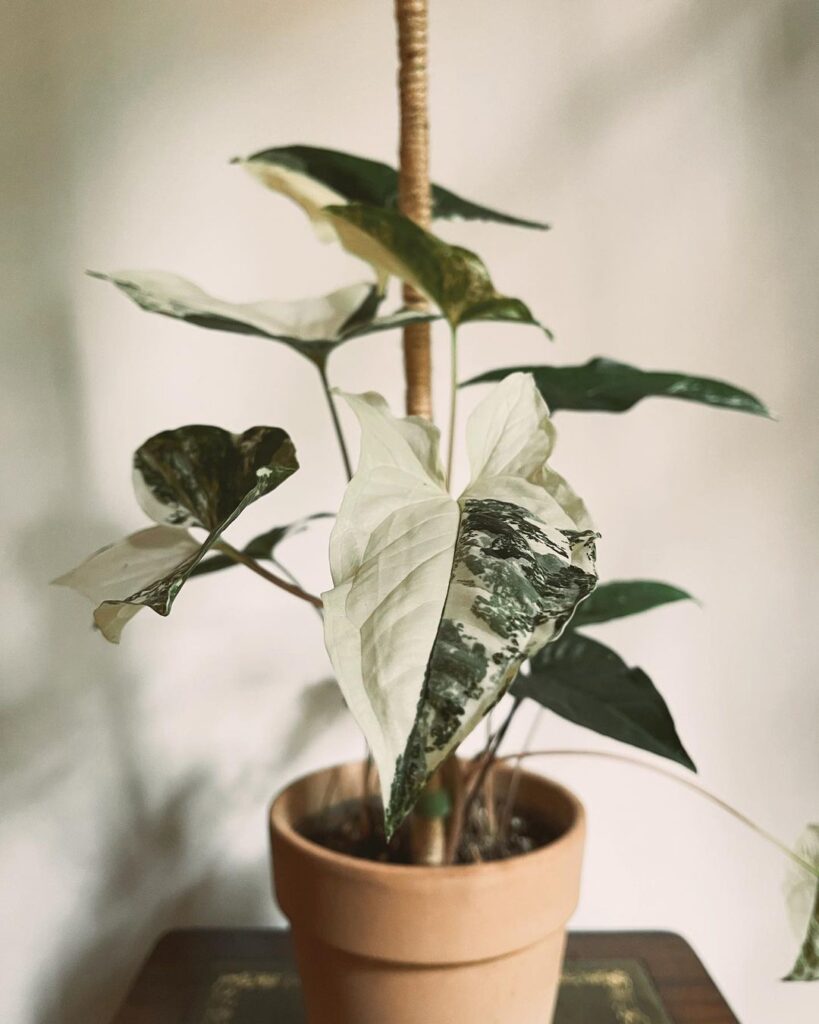
Propagation
Propagating Syngonium plants is an excellent strategy to grow new seedlings or preserve a dying plant. These plants may be reproduced primarily in two ways:
(1) Shoot-cutting propagation
(2) Water propagation
Propagation by shoot-cuttings
The stem-cutting technique necessitates cutting stems from a mother plant. To achieve this, place the shoot in rooting media. After the development of the roots, the cutting can be handled as a separate plant and allowed to develop in the preferred place.
Simply trim the stem tip to 5 to 7 inches in length. Remove a couple of the lower leaves. Plant the cutting in well-prepared, moist soil. To allow for root growth, make sure there are at least three nodes beneath the soil.
Propagation of water
The plant may also grow in water. Just submerge the shoot cuttings in a water-filled bowl. Ensure that two or three nodes are present beneath the water. In around three to four weeks, root growth will begin. You may even move the water dweller to the soil after the roots have developed.
Pruning
Pruning Syngonium Variegata can help the plant maintain its form but is not necessary for the plant’s health.
Plants can be clipped and pinched back to prevent rambling and promote a more compact appearance because this plant is a natural climber and has a propensity to grow “leggy.” Trim any damaged or dead stems or leaves as needed all year long.
Potting and Repotting
Syngonium flourishes in hanging, ceramic, or terracotta pots with airy soil and sufficient drainage that have large drainage holes at the bottom. Repotting should be done in the spring and early summer. Repot your Syngonium every two years.
Since the fresh soil contains new nutrients, your plants will be happy. As soon as you observe roots poking out of the drainage holes, repot the plant to prevent the roots from becoming congested.
Syngonium Variegata Care
| Light | Medium to Bright indirect light |
| Temperature | Intermediate to warm, 60-80 degrees Fahrenheit |
| Water | Once a week, increased in summer, decreased in winter |
| Soil | Well-draining, organic rich, moist soil |
| Fertilization | Regular household fertilizer, once a month |
| Space | Climbing space |
| Propagation | Via stem propagation and water propagation |
| Blooming | Rarely blooms, enough sunlight and maturity needed |
| Pruning | Regular pruning |
| Potting | Regular potting mix, use of perlite recommended |
Related: Calathea White Star: The #1 Care, Propagation, and Watering Guide
Problems and Troubleshooting
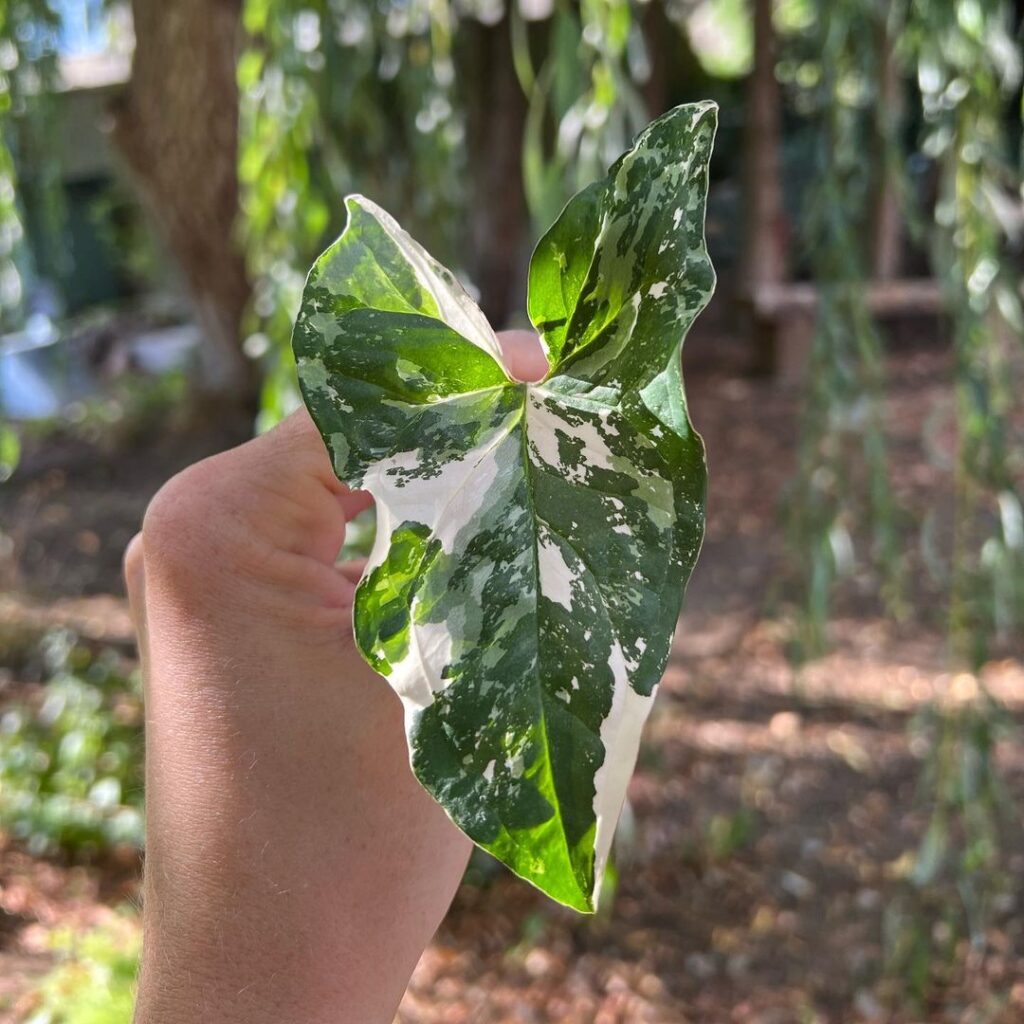
Overwatering
Overwatering Syngonium plants can significantly lower the quantity of oxygen roots required to survive. Excessive water use may cause root rot, sogginess, and permanent root deterioration.
When a plant is overwatered, the leaves become yellow, stopping the plant’s growth and making it seem sickly.
To avoid this problem, ensure the drainage holes in the planters are not clogged. Check the soil for suitable composition and texture if the pot is in excellent shape. Water the plant sparingly and infrequently, and leave it to dry out between waterings.
Underwatering
Syngonium turns curled and brown when underwater. Moreover, direct sunlight causes burning, which results in brown foliage. Therefore, growers may advise watering the plant on a regular basis in accordance with its watering schedule and keeping it away from direct sunlight to avoid this problem.
Nutrient Deficiency
Plants can become deficient when growth conditions are poor, and they are unable to absorb nutrients from the soil. Plants that are deficient in minerals like calcium, magnesium, and nitrogen grow pale, sickly leaves.
Symptoms of nutrient shortage include:
- Yellowing foliage.
- Interveinal yellowing of leaves.
- Reduced internodes.
- Aberrant color such as red, purple, or bronze leaves.
To correct this, use a well-balanced fertilizer to minimize nutritional deficiencies and support healthy development, allowing your plants to grow quickly while keeping strong stems and rich, green foliage.
Flowering Problem
The Arrowhead plant is known for its arrow-shaped or goosefoot-shaped leaves and bushy foliage, but not flowers. The plant may give off flowers in its natural habitat, but not so much when grown indoors. When a mature plant blooms, consider pruning the buds to make way for bushier foliage.
Regular pruning during spring will help keep the plant small and avoid getting bushy. Please avoid using the blossoms or flower buds from Syngonium for decorations, as they are equally toxic. Flowers used for decorations are more likely to be accidentally consumed.
Syngonium Variegata Pests And Diseases
| Common Pests/Diseases | Symptoms | Treatment and Prevention |
Common diseases include stem rot, crown rot, root rot, fungal diseases, leaf spot, and Xanthomonas infection | Yellow rims around dark brown or black spots on leaves | Do not overwater. Keep the soil dry. Avoid extreme humidity. Proper ventilation is needed around the plant. Remove infected parts of fungal infections to avoid spreading. |
Common pests include mealybugs, spider mites, aphids, and scales | Visible insects on the surface | Spray plant with warm, soapy water. If infestation is present, use insecticide or neem oil. Use diatomaceous earth. |
Related: Monstera ‘Albo’: 7 Reasons Why It Is Expensive and More Information
Problems With People And Animals
Toxicity
Arrowhead plants are extremely toxic. Therefore, kids or dogs should not touch any part of the plant because doing so can have negative effects.
The plant’s toxicity comes from the calcium oxalate substances that cause gastrointestinal distress, oral swelling, and drooling in cats. Like its distant relative, Philodendrons, Syngonium produces poisonous leaves, stems, and blossoms that can quickly make you sick if consumed.
Syngonium Meaning And Symbolism
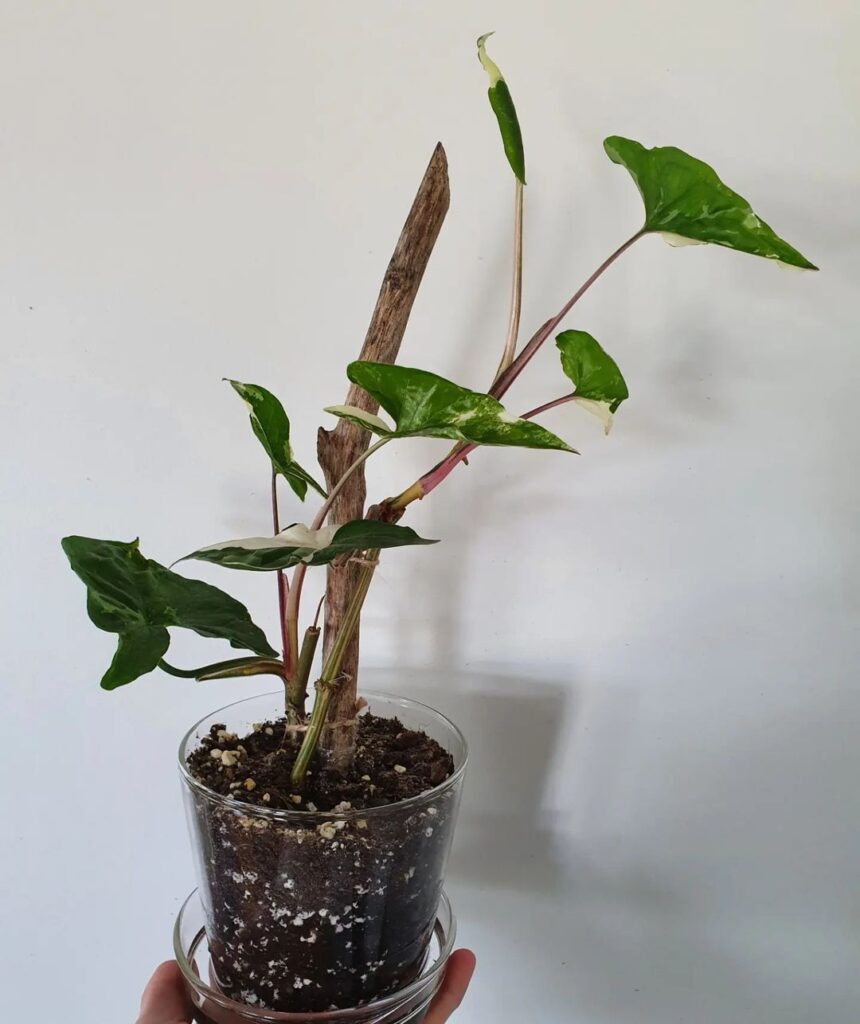
The five-lobed shape of Syngonium leaves symbolize the five Feng Shui elements: wood, metal, earth, fire, and water. As a result, it encourages positive chi or energy and perfectly balances Yin and Yang energy.
| General Meaning | Five Feng Shui elements: Wood, Metal, Earth Fire, and Water |
| Symbolism | Positive Chi, Balanced Yin and Yang energy |
Landscaping and Gardening Ideas
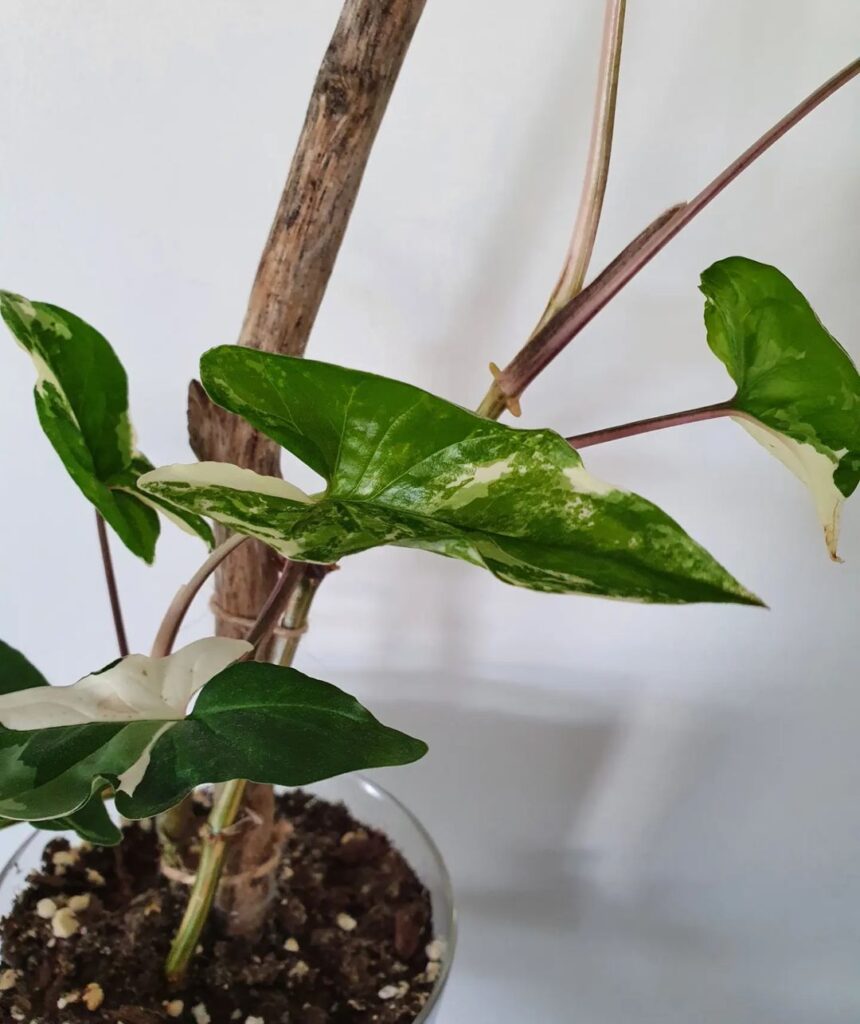
Companion Plants
Dieffenbachia and Ficus are excellent for Syngonium companion plants.
Dieffenbachia is a perennial herbaceous plant with a straight stem and simple and alternating leaves with white dots and specks that look great as interior greenery. Because of their shade tolerance, species in this genus are popular as houseplants.
Furthermore, Ficus belongs to the evergreen, semi-evergreen, and deciduous plant families, which encompass nearly every plant form imaginable, including trees of the large, medium, and low growth, as well as shrubs, vines, and climbers.
Landscaping Ideas
Syngonium is a fast-growing, trailing plant with attractive leaves that works well in tiny containers and on trellises.
It is great for indoor design because of its appealing coarse-textured foliage with beautiful leaves and patterns. This gorgeous plant may be planted in attractive containers on windowsills in living rooms, bedrooms, and hallways.
| What to plant with | Dieffenbachia, Ficus, Other Syngonium Plants |
| What NOT to plant with | Basically nothing |
Conclusion

Syngonium variegata, an epiphytic vine, is appreciated for its low maintenance, making it excellent for novices. This is a great, excellent shrub with gorgeous, fragrant blossoms and magnificent, thick, green foliage. It is a good choice for growing a plant that will thrive in the humid environment of your home.
Undeniably, the Variegated Syngoniums are excellent choices for anyone who wants to add some greenery to their indoor setting but does not have a lot of natural light.
However, the plant’s leaves should not be handled since it contains calcium oxalate crystals that might irritate the skin of some individuals.
Frequently Asked Questions
How do you keep Syngonium variegations?
To maintain the variegations of your plant, maintain the optimum light, humidity, and temperature. Always avoid direct sunlight, which will make your leaves brown and eventually burn. Low light, on the other hand, makes your plant more green.
Is Variegated Syngonium rare?
Yes, the gorgeous variegated aroid is a rare plant. However, the Variegated Syngonium, with its vibrant green and white variegations, is a must-have for any plant collector. The varieties are variable, so each new foliage is definitely a surprise!
Why are my Syngonium Variegata leaves curling?
Curling Syngonium leaves are usually due to low humidity or underwatering. However, extreme light also causes curling of leaves, thus ensuring your plant is in bright indirect light.
If this is a watering problem, ensure to water your plants on time properly. However, as a general rule, only water your plants when the top soil is dry. Check the soil moisture by sticking a ruler or your finger on the top 2-3 inches of soil. If it’s dry, water your plant. If it is still moist, wait it out to ensure your plant from overwatering.
Is Syngonium Variegata an indoor plant?
Yes, your Syngonium Variegata can be grown indoors as it can tolerate the environmental conditions inside your home. Although their growth is limited indoors, they can still thrive like how they can when they are outdoors. Just ensure optimum light, temperature, humidity, and watering.
Is Syngonium Variegata toxic?
Like your other Aroid plants, such as Philodendrons and Monsteras, your Syngonium plants are toxic because of the calcium oxalate crystals. Always keep these plants away from your pets and small children to avoid further complications.
Editor’s Recommendations
Alocasia Mickey Mouse: A Useful and Complete Care, Propagation, and Watering Guide
11 Outdoor Foliage Plants To Arrange Your Garden Like A Professional Landscape Designer







